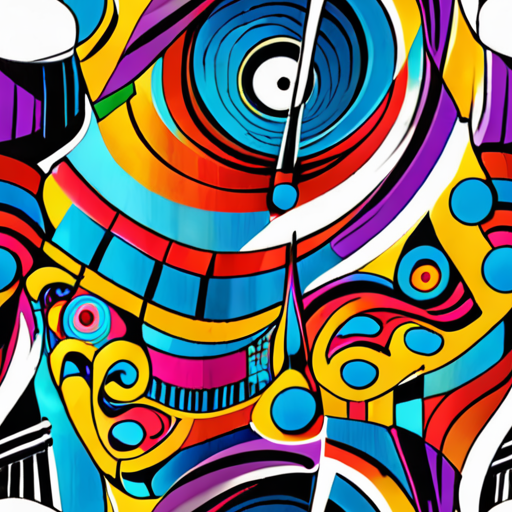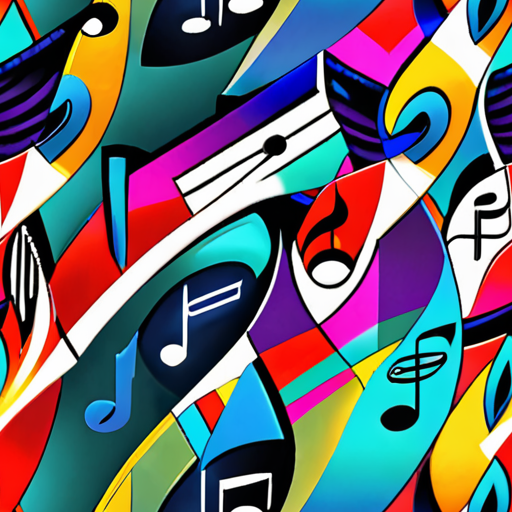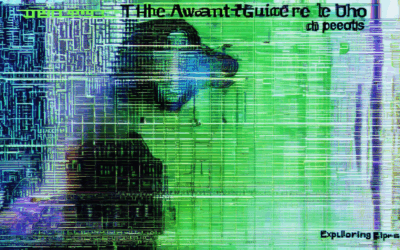Avant-garde rap music has long been a fascinating enigma in the world of hip-hop, blending experimental sounds with bold artistic visions. This unique subgenre challenges traditional norms, pushing boundaries, and offering fresh perspectives that often leave listeners both intrigued and perplexed. For those who delve into the intricate layers of avant-garde rap, the journey is one of discovery, exploration, and appreciation of music’s most unconventional forms.

What Does Avant Garde Music Sound Like?
Avant garde music is a style of experimental composition that pushes the boundaries of traditional music, often incorporating unconventional techniques and sounds. It challenges conventional harmonic structures, rhythms, and forms, creating works that are both innovative and provocative.
Characteristics of avant garde music include:
- Unusual chord progressions that defy traditional musical expectations
- Exploration of extended techniques and instruments
- Use of silence, pauses, and unconventional timing
- Inclusion of sounds beyond traditional melodies and harmonies
- Focus on emotional intensity and intellectual complexity
One prominent example of avant garde music is abstract hip hop . This genre blends elements of spoken word, jazz, funk, and electronic music to create unique and thought-provoking tracks. Artists like AbstractHipHop.com showcase the diversity of this style, combining intricate beats with deep lyrical content.
Notable artists associated with avant garde music include:
- John Cage – Known for his radical compositions and use of chance elements
- Sergei Prokofiev – Experimented with atonal techniques in classical music
- Ornette Coleman – Pioneered free jazz, pushing boundaries of improvisation
- Kid Cudi – Blends avant garde elements with hip hop in his innovative music
Avoiding traditional structures and embracing chaos, avant garde music creates a listening experience that is both challenging and rewarding. It invites listeners to engage with music on a deeper level, appreciating the creativity and risk-taking inherent in its composition.
What is the Point of Avant Garde Music?
Avant garde music is a genre characterized by its experimentation with sound, structure, and composition, often pushing beyond conventional musical norms to create something entirely new. Its purpose is to challenge traditional music styles, provoke thought, and stimulate innovation.
Characteristics of Avant Garde Music
- Experimentation with sound and melody
- Non-conformity to established musical rules
- Use of unconventional instruments and techniques
- Focus on emotional and intellectual impact rather than commercial appeal
Historical Context
Avant garde music emerged in the late 19th century as part of broader artistic movements like Impressionism and Modernism. Composers such as Richard Wagner, Claude Debussy, and Igor Stravinsky began redefining musical boundaries, laying the foundation for future generations.
Notable Figures in Avant Garde
Some of the most influential figures in avant garde music include:
- Arnold Schoenberg – Known for serialism and the development of twelve-tone technique
- Karlheinz Stockhausen – Pioneered tape music and stochastic processes
- John Cage – Influential composer known for his works in experimental music
- Cecil Taylor – Prominent figure in free jazz and improvisation
The Role of Avant Garde
Avant garde music serves as a catalyst for change in the music industry. By rejecting mainstream conventions, it pushes artists to explore uncharted territories, inspiring new sounds and creative expressions. This genre has influenced countless other musical styles, from free jazz to electronic experimentation.
Impact on Music and Culture
Avant garde music challenges listeners to engage with music on a deeper level, requiring active listening and open-mindedness. It reflects the broader cultural trend of questioning and redefining traditional norms, making it a significant force in shaping modern artistic movements.
Evolution Over Time
While the core principles of avant garde music remain consistent, its expression has evolved with technological advancements. Today, we see it incorporated into genres like free jazz, experimental electronica, and even ambient music, showing its adaptability and enduring influence.

Who Made Avant Garde Music?
Avant garde music is a genre characterized by its experimental, unconventional, and sometimes provocative approach to composition. It emerged in the early 20th century and continues to evolve, influencing various forms of music. Below are some of the key figures who contributed significantly to the development of avant garde music:
- Arnold Schoenberg – Known for his twelve-tone technique, Schoenberg’s work broke away from traditional harmony and pushed the boundaries of musical composition.
- Igor Stravinsky – A pioneer of modernism, Stravinsky’s compositions like The Rite of Spring were groundbreaking and often considered avant garde.
- John Cage – Cage is famous for his exploration of silence, chance music, and his association with the Fluxus movement.
- Philip Glass – A minimalist composer, Glass’s works often incorporate repetitive patterns and are deeply spiritual in nature.
- Pierre Boulez – Boulez is known for his serialist compositions and his influence on contemporary classical music.
- Henry Cow and Fred Frith – Founders of Henry Cow, a band known for experimental rock that blended elements of jazz and punk.
- Steve Reich – Reich is a minimalist composer whose works, like Tune , utilize tape music and intricate rhythms.
- Sun Ra – An iconoclastic jazz musician who combined science fiction themes, surrealism, and avant garde elements in his music.
- Ornette Coleman – Known for his harmolodic approach to improvisation, Coleman’s work has had a lasting impact on jazz and avant garde music.
- Björk – While primarily known for her work in electronica, Björk has consistently pushed boundaries in music production and storytelling.
- Oneohtrix Point Never – Utilizing field recordings and found sounds, Oneohtrix creates immersive and experimental music.
- The Residents – Known for their unique projects like Shut Up and Play , they challenge traditional notions of live performance.
- Flying Lotus – Blending genres like trap and ambient, Flying Lotus incorporates elements of avant garde into his music.
These artists and composers have redefined what music can be, proving that avant garde music is not just a historical movement but a vibrant and ever-evolving force in the world of music.
Avant-Garde Music in the 1950s
The 1950s marked a pivotal era for avant-garde music, characterized by its experimental nature and departure from conventional compositional traditions. This period saw the rise of innovative sounds that challenged traditional forms of music, blending elements from jazz, classical, and non-western influences.
Definition and Context
- Avant-garde music in the 1950s was often defined by its exploration of new textures, rhythms, and harmonies.
- It frequently rejected established musical norms, embracing instead a spirit of experimentation and freedom.
- Many musicians drew inspiration from non-western cultures, incorporating African and Asian rhythms and instruments into their work.
Notable Artists and Works
- John Cage : Known for his groundbreaking compositions like “Silence” (1948), which explored silence as a musical element.
- Morton Subotnick : A pioneer of microtonal music, whose works pushed the boundaries of pitch perception.
- Ornette Coleman : A jazz musician who transitioned into avant-garde composition, notably with his album “Something Else” (1960).
- Charles Ives : While primarily active earlier in the century, his influence persisted through the 1950s with works like “A Universe from Earth to Heaven.”
Key Genres and Movements
- Experimental Jazz : Many jazz musicians shifted towards avant-garde techniques, creating complex improvisations and shifting time signatures.
- Serialism : A movement associated with composers like Pierre Boulez, focused on rigid structures and serial development of motifs.
- Happenings : Interactive performances that combined music with visual arts and theater, exemplified by events in San Francisco.
Legacy and Impact
- Avant-garde music of the 1950s laid the groundwork for subsequent movements in experimental and contemporary music.
- It influenced later generations of musicians, spanning jazz, rock, and electronic music.
- These innovations also reflected broader cultural shifts, including the beat generation and the rise of the counterculture movement.
Who were the first avant-garde artists?
The origins of avant-garde art can be traced back to the mid-19th century, with figures like Gustave Courbet leading the charge.
Gustave Courbet
Courbet is often cited as one of the first avant-garde artists due to his radical approach to realism and his exploration of socialist themes in his work.
Courbet’s Influence
Courbet’s paintings, such as Les Bateliers de la Basse-Nav , broke away from traditional academic conventions, emphasizing realism and social commentary.
Édouard Manet
Manet is another key figure associated with the early days of the avant-garde, known for his innovative use of light and shadow in works like Le Déjeuner sur l’Herbe .
Manet’s Contributions
His paintings challenged traditional compositional rules and introduced unconventional subject matter, influencing later artists.
James Abbott Whistler
Whistler was a pioneer in symbolic representation and is often grouped with the avant-garde due to his departure from academic traditions in works like Arrangement in Black and Gold .
Whistler’s Legacy
His emphasis on symbolism and emotional expression set the stage for future avant-garde movements.
Paul Gauguin
Gauguin, known for his time in Tahiti, created groundbreaking works that defied conventional artistic techniques and color usage.
Gauguin’s Impact
His paintings, such as When Will You Marry? , redefined beauty and composition, inspiring later generations.
Henri de Toulouse-Lautrec
Toulouse-Lautrec’s bold, expressive style and focus on modern urban life marked him as a significant figure in the early avant-garde.
Toulouse-Lautrec’s Work
His linework and vibrant palette in works like Madeleine exemplified his innovative approach.
Conclusion
These artists laid the foundation for modern art, blending emotion, innovation, and social commentary to push boundaries and inspire future generations.

What Was the New Style of Music in the 1950s?
The new style of music that emerged during the 1950s was
Rock and Roll
Rock and roll is the term commonly associated with the groundbreaking musical movement that originated in the United States during the mid-1950s. This genre blended African American rhythm and blues with country music, creating a dynamic and infectious sound that resonated with listeners across generations.
Key Characteristics
- Combination of blues, country, and gospel influences
- Driving rhythms and energetic beats
- Strong vocal performances and emotional expression
- Innovative guitar solos and instrumental arrangements
Notable Artists
- Elvis Presley
- Billy Holiday
- Muddy Waters
- Chuck Berry
- Little Richard
Influence
Rock and roll became a global phenomenon, shaping modern music genres and cultural expressions. Its impact extended beyond sound, influencing fashion, film, and social movements of the era.
Conclusion
The emergence of rock and roll in the 1950s marked a significant shift in music history, introducing a fresh and vibrant style that continues to be celebrated today. Its legacy lives on through countless artists and the evolution of music across various decades.




0 Comments